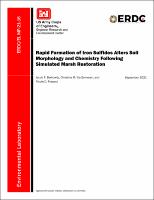Please use this identifier to cite or link to this item:
https://hdl.handle.net/11681/42155Full metadata record
| DC Field | Value | Language |
|---|---|---|
| dc.contributor.author | Berkowitz, Jacob F., 1979- | - |
| dc.contributor.author | VanZomeren, Christine M. | - |
| dc.contributor.author | Fresard, Nicole D. | - |
| dc.date.accessioned | 2021-09-29T19:17:18Z | - |
| dc.date.available | 2021-09-29T19:17:18Z | - |
| dc.date.issued | 2021-09 | - |
| dc.identifier.govdoc | ERDC/EL MP-21-16 | - |
| dc.identifier.uri | https://hdl.handle.net/11681/42155 | - |
| dc.identifier.uri | http://dx.doi.org/10.21079/11681/42155 | - |
| dc.description | Miscellaneous Paper | en_US |
| dc.description.abstract | Many marshes show signs of degradation due to fragmentation, lack of sediment inputs, and erosion which may be exacerbated by sea level rise and increasing storm frequency/intensity. As a result, resource managers seek to restore marshes via introduction of sediment to increase elevation and stabilize the marsh platform. Recent field observations suggest the rapid formation of iron sulfide (FeS) materials following restoration in several marshes. To investigate, a laboratory microcosm study evaluated the formation of FeS following simulated restoration activities under continually inundated, simulated drought, and simulated tidal conditions. Results indicate that FeS horizon development initiated within 16 days, expanding to encompass > 30% of the soil profile after 120 days under continuously inundated and simulated tidal conditions. Continuously inundated conditions supported higher FeS content compared to other treatments. Dissolved and total Fe and S measurements suggest the movement and diffusion of chemical constituents from native marsh soil upwards into the overlying sediments, driving FeS precipitation. The study highlights the need to consider biogeochemical factors resulting in FeS formation during salt marsh restoration activities. Additional field research is required to link laboratory studies, which may represent a worst-case scenario, with in-situ conditions. | en_US |
| dc.description.sponsorship | Dredging Operations and Technical Support Program (U.S.) | en_US |
| dc.description.sponsorship | Ecosystem Management and Restoration Research Program (U.S.) | - |
| dc.description.sponsorship | United States. Army. Corps of Engineers. Philadelphia District. | - |
| dc.format.extent | 14 pages / 1.34 MB | - |
| dc.format.medium | - | |
| dc.language.iso | en_US | en_US |
| dc.publisher | Environmental Laboratory (U.S.) | en_US |
| dc.publisher | Engineer Research and Development Center (U.S.) | - |
| dc.relation.ispartofseries | Miscellaneous Paper (Engineer Research and Development Center (U.S.)) ; no. ERDC/EL MP-21-16 | - |
| dc.relation.isversionof | Berkowitz, Jacob F., Christine M. VanZomeren, and Nicole D. Fresard. "Rapid formation of iron sulfides alters soil morphology and chemistry following simulated marsh restoration." Geoderma 351 (2019): 76-84. https://doi.org/10.1016/j.geoderma.2019.05.028 | - |
| dc.rights | Approved for Public Release; Distribution is Unlimited | - |
| dc.source | This Digital Resource was created in Microsoft Word and Adobe Acrobat | - |
| dc.subject | Iron sulfide | en_US |
| dc.subject | Soil acidity | en_US |
| dc.subject | Marsh restoration | en_US |
| dc.subject | Soil morphology | en_US |
| dc.subject | Depleted matrix | en_US |
| dc.title | Rapid formation of iron sulfides alters soil morphology and chemistry following simulated marsh restoration | en_US |
| dc.type | Report | en_US |
| Appears in Collections: | Miscellaneous Paper | |
Files in This Item:
| File | Description | Size | Format | |
|---|---|---|---|---|
| ERDC-EL MP-21-16.pdf | 1.34 MB | Adobe PDF |  View/Open |